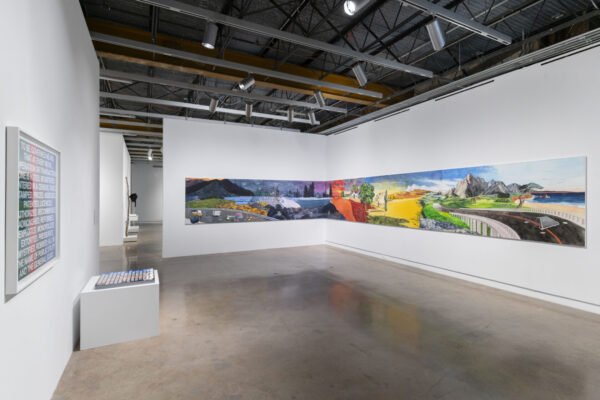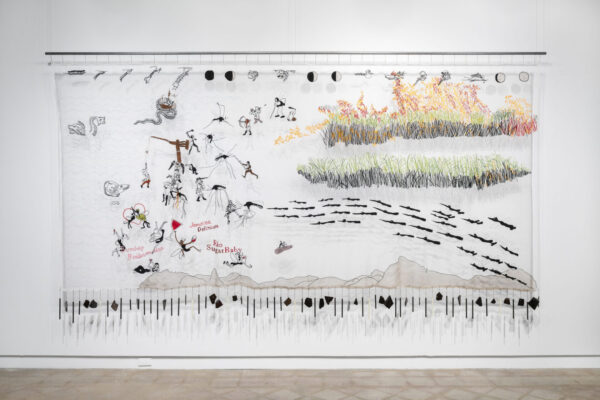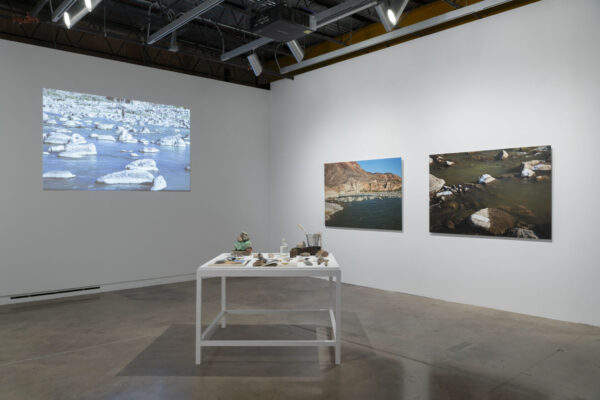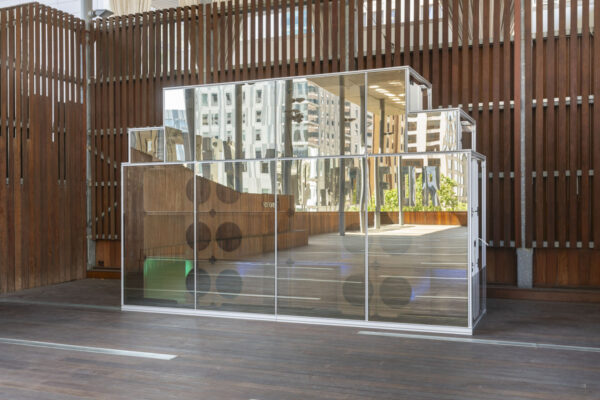Austin, Texas is not the same city it used to be. The scapegoats at fault? Californians, tech bros, Joe Rogan, and, more recently, the Hermes store on South Congress. However, skyrocketing real estate is the real push factor. The cost of living is unsustainable for creatives, independent businesses, and generational residents, and gentrification is proliferating. Despite local dismay, this trend is not unique to Austin and did not materialize out of the ether. These shifts are rooted in the bedrock systems that are the foundation of our social infrastructure, and play a role in changing physical and sociopolitical landscapes.
At The Contemporary Austin, five artists bring these systems to the fore, revealing how their relationship to colonial capitalism has evolved over decades of ideological development and continues shifting our sense of place. Curated by Robin K. Williams, This Land features Vivian Caccuri, Raven Chacon, Minerva Cuevas, Danielle Dean, and Jamilah Sabur. All five artists reside in different regions of the Americas, and each interrogates a different niche through the lens of their locality. Displayed together, the artists’ works demonstrate the global effects of structural systems that shape our understanding and the appearance of the land we occupy, while also tracing decades of change.

Installation view, “This Land,” The Contemporary Austin. Image courtesy The Contemporary Austin. Photo: Alex Boeschenstein.
Entering the downstairs gallery at the Jones Center, Danielle Dean opens the group show with a 35.5-foot-long watercolor landscape contoured into the corner of a wall. The painting, titled 11 p.m., 2:05 a.m., 5:10 a.m., 12:45 p.m., and 5 p.m., comprises five panels. Each vignette features a region of the United States, traversing from right to left, the East Coast to the West Coast, but each regional signifier is stylized as if didactic. The imagery is informed by Dean’s collection of Ford car advertisements dating from the 1920s to the present. An empty road weaves through the painted panels of the landscape, but Dean has subtracted the vehicles and humans original to the source material. Instead, we only see evidence of their former presence: abandoned homes, littered water bottles, a plastic lawn chair, a desk with two computer monitors (one with a screen displaying the very landscape beyond its frame) — all details that have been featured in Ford advertisements.
Dean wields advertising’s uncanny idealizations to yield an unsettling scene that implies human extinction. The sea-to-sea landscape refers to manifest destiny while philosophizing advertising’s systemic role within the mass media to disseminate messages and promote consumerism, ultimately revealing the detritus these agendas leave to deface the environment once we’re gone. In a sense, the painting also serves as a thematic roadmap and timeline for This Land.

Danielle Dean, “11 p.m., 2:05 a.m., 5:10 a.m., 12:45 p.m., and 5 p.m.,” on view in “This Land” at The Contemporary Austin. Image courtesy The Contemporary Austin. Photo: Alex Boeschenstein.
Man and Water
Throughout 11 p.m., 2:05 a.m., 5:10 a.m., 12:45 p.m., and 5 p.m.— and specifically the ocean in the first panel of the painting — the relationship between human inhabitation and water serves as a starting point to the timeline of This Land and acts as a recurring theme throughout the exhibition. Next in the show, Tremble Staves, by Pulitzer Prize-winning composer and performer Raven Chacon, explores an expansive history of a place, beginning before human inhabitation. Water is central to the narrative, and Chacon acknowledges its sanctity and the ongoing conflicts regarding its accessibility and the inequities thereof. Here, Chacon premieres a video installation of the 2019 Tremble Staves performance at Sutro Baths in San Francisco, and also debuts the costumes and objects used in the performance.

Raven Chacon, “Tremble Staves,” on view in “This Land” at The Contemporary Austin. Image courtesy The Contemporary Austin. Photo: Alex Boeschenstein.
Moving forward in the timeline, Jamilah Sabur explores the colonial origins of offshore mining in her video installation The Harvesters. Alluding to Pieter Bruegel’s 1565 painting of the same title, The Harvesters considers the effects of colonial and present-day corporate oceanic endeavors. Vivian Caccuri also researches the history of colonial seafaring as she parallels the violent history of slavery with the history of the mosquito in the Americas. Mosquito Shrine II is a hand-embroidered netting that casts the mosquito as an invader, instigating biological warfare by leaving disease in its wake. In the work, the mosquito battles are depicted along the shore next to rolling waves, since the point of colonial contact historically occurred on sea shores where colonizers arrived, muddying such waters with bloody histories.

Vivian Caccuri, “Mosquito Shrine II,” on view in “This Land” at The Contemporary Austin. Image courtesy The Contemporary Austin. Photo: Alex Boeschenstein.
Conversely, Minerva Cuevas negates violent depictions of the waters of the Rio Grande in her project Río Bravo Crossing. Video footage, archival materials, and objects that Cuevas collected from the landscape document the action she took in painting a symbolic bridge across the Rio Grande, undermining its designation as a political border between the U.S. and Mexico. Cuevas eschews the border warfare perpetuated by the media, opting to instead connect with the serenity of the landscape by walking back and forth between the two countries, emulating the migratory path people have walked for thousands of years. However, it’s worth noting that Cuevas completed Río Bravo Crossing in 2010, meaning the piece does not reflect the current environment of the immigration crisis in Texas, where migrants are maimed by barbed-wire covered buoys.

Minvera Cuevas, “Río Bravo Crossing,” on view in “This Land” at The Contemporary Austin. Image courtesy The Contemporary Austin. Photo: Alex Boeschenstein.
Man and Urbanscape
Dean’s landscape painting takes us along a winding path through the Appalachian mountain range, over swells of rolling green hills, across the sprawling Southwest, and further westward. The construction of the Interstate Highway System in the U.S. drastically altered the face of the landscape while also facilitating unprecedented cross-country travel that in turn increased the commercialization of oil and gas companies.
If we are to use Dean’s painting as a conceptual timeline for the exhibition, then Cuevas’s second installation on the second floor of the Jones Center accelerates us into the mid-20th century, where her Selection of Motor Oil Vases reflects the research she has done in the petroleum industry, especially in Texas. Cuevas collects vintage aluminum motor oil cans and fills them with colorful fake flower arrangements. Vintage paper advertisements from petroleum companies with bases in Texas are also on display, unaltered from their original publication date and framed on the wall. The rusted cans are representative of decades of exploitative industry practices, while the blooms ironically remind us of the environmental repercussions of those practices, which we also participate in every day during our own commutes. The ads encapsulate a mythological formula that promotes both oil sales and American colonial capitalist agendas, like rubber tree harvesting and the Vietnam War, both of which are featured in the displayed ads.

Minerva Cuevas, “Selection of motor oil vases,” on view in “This Land” at The Contemporary Austin. Image courtesy The Contemporary Austin. Photo: Alex Boeschenstein.
If we continue to follow Dean’s great American apocalyptic and conceptual road map, we see a steep roller coaster rise from the landscape, rivaling the surrounding mountains. The frame’s intricate pattern reminds me of the scaffolding built when a new skyscraper is undergoing construction, a feat of development that transformed cityscapes in the 20th century and is now commonplace to our daily sightlines. Cacurri’s second installation in This Land is installed on the rooftop of the Jones Center and quite literally reflects the urban environment. Bass Mass is a rectangular sculpture made from the same reflective material used on the facade of skyscrapers, which encases several stacked speakers. In collaboration with local musician Mama Duke, the duo created a song about Austin’s changing landscape and its effects on the local music community. The sculpture reflects both its physical and sonic environment and will be activated by Mama Duke’s performance on January 24 as a part of The Contemporary’s Rooftop Sessions.

Vivian Caccuri, “Bass Mass,” on view in “This Land” at The Contemporary Austin. Image courtesy The Contemporary Austin. Photo: Alex Boeschenstein.
Man and Machine
Back on the road navigating Dean’s conceptual roadmap, we see rows of supercomputers nestled into a valley. They morph together as they extend backward into the landscape, forming a blue mass that resembles the bay of water just on the other side of the mountains. This is where the present intersects with the future in This Land’s timeline, representing today’s technological environment while forecasting the future of the tech industry.
Danielle Dean’s Amazon does the same, closing the thematic circuit that her painting begins in opening the show and bringing us to the present-day on the exhibition’s timeline. The video and mixed media installation simulates a labor program that draws on two past and current working environments: Ford’s failed work camp, Fordlândia, which was built in the Amazon rainforest in 1928, and Amazon’s Mechanical Turk (MTurk), which crowdsources labor to generate data for machine learning. The script, which Dean wrote in collaboration with MTurk workers, examines the reality of both programs’ influence on the physical landscape and the psychological conditions of its workers, while imagining a future in which colonial exploitation of land, resources, and people continues in the service of artificial intelligence. The actors, including Dean, advocate for the work program, speaking and behaving with corporate-robot affectation as if the machines they’re “teaching” are draining their life force. While watching the video, I pondered the long-term effects of work programs like MTurk. Computers ascending to a higher level of consciousness and eventually usurping us as the ruling species seems like sci-fi fear-mongering, but in Dean’s painting, the supercomputers glow with activity despite human absence.

Danielle Dean, “Amazon,” on view in “This Land” at The Contemporary Austin. Image courtesy The Contemporary Austin. Photo: Alex Boeschenstein.
Austin is among the fastest-growing cities in the U.S., and its physical and cultural changes are indicative of the underlying systems that were laid as colonial pursuits expanded across the landscape, becoming foundational to social, economic, and political infrastructures. This Land effectively tracks a timeline of how these systems have developed globally over centuries. Equipped with the knowledge of how these systems have been embedded into societal structures allows us to make necessary counter-changes. For example, This Land coincides with The Contemporary’s research into the ecological and historical significance of the land at Laguna Gloria, the museum’s outdoor sculpture park, which will inform revised public signage and didactic materials on the grounds to acknowledge its importance to indigenous communities and environmental maintenance. This Land evaluates the changing landscape by considering a larger timeline that extends below surface-level symptoms, and takes a crack at dismantling their skewed foundations — and as Austin homeowners are sure to know, a crack in the foundation goes a long way.
This Land is on view through January 28 at The Contemporary Austin’s Jones Center. Mama Duke will perform on January 24 as a part of The Contemporary’s Rooftop Sessions.


